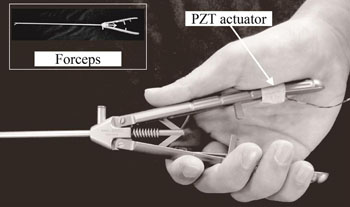Stochastic Resonance Enhances Surgeon’s Haptic Sensation
By HospiMedica International staff writers
Posted on 24 Aug 2016
A novel device can be slipped onto any surgical tool to vibrate against a surgeon’s palm, improving the ability to sense the details of a patient’s internal tissues and organs.Posted on 24 Aug 2016
The PZT Actuator, developed at Hiroshima University (Japan), is a vibration device that works via the stochastic resonance effect, a mathematical principle that describes how a constant and regular signal can boost the strength of another irregular signal. The device produces vibrations that are so subtle they cannot be sensed; but the constant, uniform vibration of the actuator enhances the surgeon’s sensitivity to other, irregular sensations. As a result, the touching of different tissues with a metal tool, which may normally be too subtle for the surgeon to detect, is boosted to a noticeable level.

Image: The PZT Actuator attached to standard surgical forceps (Photo courtesy Yuichi Kurita, Hiroshima University).
In a study to test the device, the lead-zirconate-titanate PZT actuator was placed on the grip of surgical forceps. Volunteers were blindfolded and asked to use the forceps to try and identify different textures of sandpaper, as well as find a small Styrofoam ball inside a cup filled with silicone. The results revealed that the vibration intensity significantly improves sensitivity. The device does not need to be fine-tuned to each user’s unique sense of touch, meaning the PZT Actuator should be robust and simple to use. The study was published on July 14, 2016, in IEEE/ASME Transactions on Mechatronics.
“The PZT Actuator remains safe for patients because the device is only on the handles of the surgeon’s tools, not inside the patient’s body. The vibrations are so subtle that they do not shake the tool. The electrical power supply is also safe for doctors and patients,” said lead author Yuichi Kurita, PhD. “Our next set of experiments will confirm the usefulness of the PZT Actuator in surgical situations. Before we can give this tool to surgeons, we must also develop a method to maintain good hygiene of the device so it is always safe for patients.”
Stochastic resonance boosts any signal by adding a white noise, which contains a wide spectrum of frequencies. The frequencies in the white noise corresponding to the original signal's frequencies will resonate with each other, amplifying the original signal while not amplifying the rest of the white noise, thereby increasing the signal-to-noise ratio, which makes the original signal more prominent. Further, the added white noise is detectable by the sensor, which can then filter it out to effectively detect the original, previously undetectable signal.
Related Links:
Hiroshima University













.jpg)
